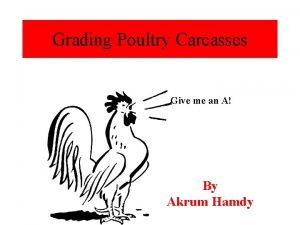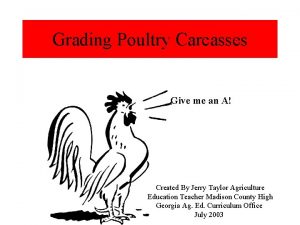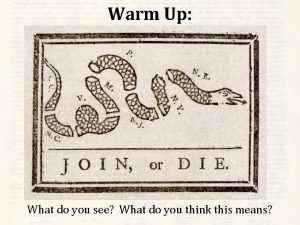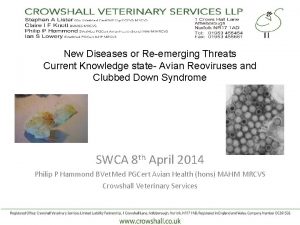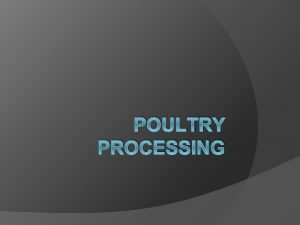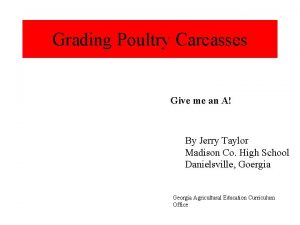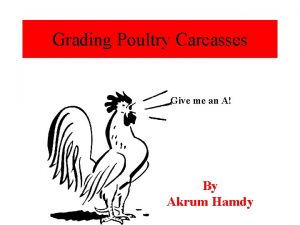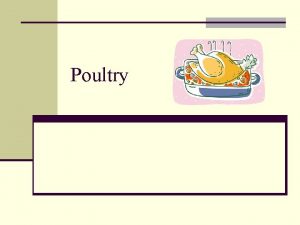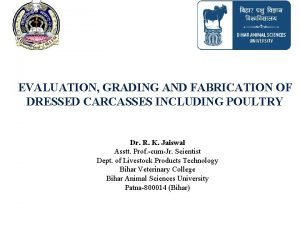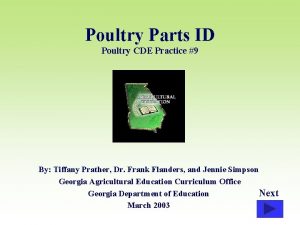Grading Poultry Carcasses Give me an A Created














- Slides: 14

Grading Poultry Carcasses Give me an A! Created By Jerry Taylor Agriculture Education Teacher Madison County High Georgia Ag. Ed. Curriculum Office July 2003

Why Grade Poultry Carcasses? • To insure quality before it is sold. • Keeps you from selling unwholesome poultry. • Did you know that grading is voluntary and paid for by the meat packer?

What are the Grades of poultry carcasses? • A - Sold in stores. • B – Often not a grade sold in stores. • C – Usually used for processing into other chicken foods. • Nongradable

Standards of an A Quality Poultry Carcass Factor A Quality Conformation Normal Fleshing & Fat covering Well fleshed with a well developed layer of fat. ¼” on breast & Legs 1” elsewhere ¾” Exposed flesh Discolorations Disjointed & Broken bones Missing Parts 1 disjointed & no broken Wing tips & tail

Standards of a B Quality Poultry Carcass Factors • Conformation • Fleshing & Fat Covering For B Grade • Moderately curved. • Moderately fleshed & fat covering. • Exposed Flesh • No more than 1/3 of part exposed. • 11/4” • 2 disjoints & no broken or 1 disjoint & 1 nonprotruding broken. • 2 nd wing joint, back not wider than base of tail and extending half way between base of tail and hip joints. • Discoloration • Disjointed & Broken bones. • Missing parts

Standards of a C Quality Poultry Carcass • Factors • Conformation • Fleshing & Fat Covering • Exposed Flesh • Discoloration • Disjointed & Broken bones. • Missing parts • C Quality • Abnormal • Poorly fleshed and covered in fat. • No Limit • wing, back not wider than base of tail and extending to area between base of tail and hip joints.

What Grade is this? A Grade No Defects

What Grade is this? B Grade Back is cut out halfway between the base of the tail and the hip joints.

What Grade is this? C Grade. More than 1/3 of flesh exposed on breast.

What Grade is this? B Grade. Parts of wing removed beyond the second joint.

What Grade is this? C Grade. Entire wing removed.

What Grade is this? C Grade. Over 1/3 of the drumstick is exposed.

What Grade is this? C Grade. Trimmed more than halfway between base of tail and hip joints.

What Grade is this? C grade. Protruding broken bone in wing tip.
 The lowest or worst grade for poultry carcasses
The lowest or worst grade for poultry carcasses Grading of poultry
Grading of poultry Give the four market forms of meat
Give the four market forms of meat What is the main idea of give me liberty or give me death
What is the main idea of give me liberty or give me death States i have been to
States i have been to Poultry farmer resources
Poultry farmer resources Market forms of poultry
Market forms of poultry Apicol
Apicol Shackling poultry
Shackling poultry Poultry world
Poultry world Broiler feeding schedule
Broiler feeding schedule Ascarex for poultry
Ascarex for poultry Poultry reproductive system
Poultry reproductive system Titri hen
Titri hen Poultry research centre
Poultry research centre
